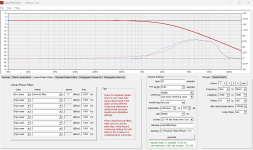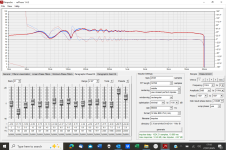Feature request,,,, (did I do this before? 🙂 )
- When eq filters and phase data is imported into one and the same rePhase session, a function to linearise phase would be cool - as now, one have to move a lot of sliders to achieve a more linear phase.
Thanks!
//
- When eq filters and phase data is imported into one and the same rePhase session, a function to linearise phase would be cool - as now, one have to move a lot of sliders to achieve a more linear phase.
Thanks!
//
Possible bug?
When I make both a phase eq and a linear phase filter, the phase dips down in HF -180 deg at 18kHz in the ADAU FIR filter i have. Seperately I get the expected result . It also works fine if I use both phase eq and linear phase gain EQ.
This is what I expect from Rephase.

BTW: Thank you for a great program!
When I make both a phase eq and a linear phase filter, the phase dips down in HF -180 deg at 18kHz in the ADAU FIR filter i have. Seperately I get the expected result . It also works fine if I use both phase eq and linear phase gain EQ.
This is what I expect from Rephase.

BTW: Thank you for a great program!
Attachments
Last edited:
You can export whatever you have in rePhase including all filter banks as a .wav file and drop it on REW or import REW filters to rePhase in multiple banks and even convert them to linear phase in rePhase if you so wish. Camilla and any other DSP engine work with FIR filters in .wav format.Understand. Here's an example - REM allows multiple filter types beyond peak if the dsp supports it. If you select Camilladsp as the dsp lots of additional filters such as shelf are available. Rephase of course supports all these types of filters, but REW can't access them, possibly because of the multiple banks feature. I put regular peak filters in Bank01 and shelving filters in Bank02. REW would have to recognize multiple banks.
A second example is on creation of the conv file, I go through a series of steps to copy over to Linux (where the music app like Moode is located), resample the files to all the possible sampling rates, and integrate into a new Camilladsp config file. It would be nice to have an "integration" hook in rephase to trigger the Python script to run all this automatically which would reduce errors and allow for much faster iterations of EQ changes.
Taking this another step, trigger the whole process from REW (which you can using the new api server).
Is it a huge issue to do these steps manually - no. And I realize that opening the rephase box for these type of changes may not be worth it. Thanks at least for listening.
Cheers, Tony
You should not correct phase like that. Export excess phase of a response from REW and try to fix that in rePhase using "filter linearization tools"Feature request,,,, (did I do this before? 🙂 )
- When eq filters and phase data is imported into one and the same rePhase session, a function to linearise phase would be cool - as now, one have to move a lot of sliders to achieve a more linear phase.
Thanks!
//
"and try to fix that in rePhase usingfilter linearization tools"
It's exactly that fixing I would like to have automated ;-)
It's really tedious to move 35 levers into the right position when a computer could it... where is the AI when one need it :-D
//
Good morning all.
I had used RePhase a couple of times successfully exporting.bin files for my MiniDSP Flex, however i now cannot save successfully in that format, it always wants to save as .Rephase which the Flex wont recognise.
Can anyone help please, a screenshot of settings attached
M
I had used RePhase a couple of times successfully exporting.bin files for my MiniDSP Flex, however i now cannot save successfully in that format, it always wants to save as .Rephase which the Flex wont recognise.
Can anyone help please, a screenshot of settings attached
M
Attachments
When you want to produce a filter from rePhase you need to press "Generate" button but first setup your desired output format using the "format" drop down menu item above.
"Save" is to keep a certain configuration of it all for a later session...
//
"Save" is to keep a certain configuration of it all for a later session...
//
Hello all.
RePhase is an impressive piece of software.
I am trying to make a FIR for filter phase linearization of a 3-way horn system. The crossover itself is done with IIR dsp, with 48LR (measured) filter slopes and crossover frequencies of 300 and 6000 Hz. The filter delay should be no more than 5 mS.
I admit to being a bit bewildered by the many options in the Impulse Settings window, and do not really understand what they all do.
What would be the "best" settings for windowing, centering and optimization?
Does this look usable?

Thanks!
RePhase is an impressive piece of software.
I am trying to make a FIR for filter phase linearization of a 3-way horn system. The crossover itself is done with IIR dsp, with 48LR (measured) filter slopes and crossover frequencies of 300 and 6000 Hz. The filter delay should be no more than 5 mS.
I admit to being a bit bewildered by the many options in the Impulse Settings window, and do not really understand what they all do.
What would be the "best" settings for windowing, centering and optimization?
Does this look usable?
Thanks!
So you’ll want to use about 500 taps to stay under 5ms latency at 48k which should be plenty
Idk why such short filter is required, I have the full 64ms latency on my home theatre and there is no video synchronize issues at all….
But that should do it , 512taps should be about 5.3ms , you may use a windowing option and could get a little more taps with low latency also , start with rectangular , then move down the list till it works , I like the Hahn window if there is a low pass on your top horn , otherwise just try them
Good luck sounds like a cool setup can you share a pic or two
Idk why such short filter is required, I have the full 64ms latency on my home theatre and there is no video synchronize issues at all….
But that should do it , 512taps should be about 5.3ms , you may use a windowing option and could get a little more taps with low latency also , start with rectangular , then move down the list till it works , I like the Hahn window if there is a low pass on your top horn , otherwise just try them
Good luck sounds like a cool setup can you share a pic or two
Thanks for answering.
The system will be used in live (club) settings, so low latency is paramount for DJ-ing.
Guess my problem is that I don't really understand the differences between the windowing options, or the finer points in centering.
I can always use trial and error till I find something that works, but I feel that some real understanding also will be good 🙂
BTW: the system is a large horn system, with B&C DCX464 coax driver in a large horn, horn-loaded 15" PHL midrange, and 2x 21" Eighteensound in bass horns.
The system will be used in live (club) settings, so low latency is paramount for DJ-ing.
Guess my problem is that I don't really understand the differences between the windowing options, or the finer points in centering.
I can always use trial and error till I find something that works, but I feel that some real understanding also will be good 🙂
BTW: the system is a large horn system, with B&C DCX464 coax driver in a large horn, horn-loaded 15" PHL midrange, and 2x 21" Eighteensound in bass horns.
Wow that’s a big horn , and a big bass driver , should sound pretty sweet …
If it’s for live sound then yes what I would do is use a 512 tap filter, and use a Hann window. Use default, centering, closest perfect example.
I would not try and linearize anything below 200 Hz because the latency will creep up on you. You could probably get away with 100 Hz if you’re OK with about 12 ms of latency but to keep it at five about 200 hz and above would be all the correction power that you’re really gonna be able to have with that short of a filter
If it’s for live sound then yes what I would do is use a 512 tap filter, and use a Hann window. Use default, centering, closest perfect example.
I would not try and linearize anything below 200 Hz because the latency will creep up on you. You could probably get away with 100 Hz if you’re OK with about 12 ms of latency but to keep it at five about 200 hz and above would be all the correction power that you’re really gonna be able to have with that short of a filter
It looks like 300-6000 rectangular window with moderate optimization, 512taps is 5.32ms at 48k
So I corrected myself I think the rectangular window is gonna work the best for you with that lower of a tap count….
If you can use 24 DB/oct slopes instead you won’t need optimization and there will be less ripple…. But it can still be done using the 48.
So I corrected myself I think the rectangular window is gonna work the best for you with that lower of a tap count….
If you can use 24 DB/oct slopes instead you won’t need optimization and there will be less ripple…. But it can still be done using the 48.
Attachments
Thank you for that.
I will try this settings.
And not linearize anything below 200 Hz: I know that then the latency or tap count will increase.
I will try this settings.
And not linearize anything below 200 Hz: I know that then the latency or tap count will increase.
Another trick I did at my church is mounted the mains behind the stage and each 13.5” got me an additional ms of latency I could use in my FIR
Although, as you know, mounting on a back wall is a bad idea, but if you have even 6 feet you can mount the speakers behind where they’re at now you can negate that 6 ms pretty easy…
Although, as you know, mounting on a back wall is a bad idea, but if you have even 6 feet you can mount the speakers behind where they’re at now you can negate that 6 ms pretty easy…
- Home
- Design & Build
- Software Tools
- rePhase, a loudspeaker phase linearization, EQ and FIR filtering tool

